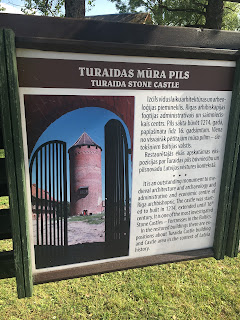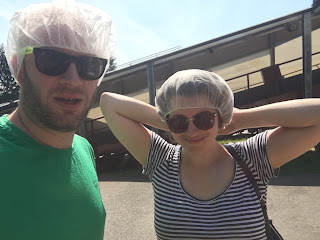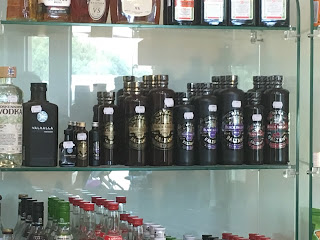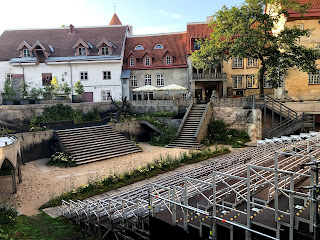Riga, Latvia was swell but I wouldn't be able to look myself in the mirror if I didn't check out the third Baltic state: Estonia.
I was sad to leave our Riga Airbnb. It was pretty awesome.
Isn't this odd? Our apartment had two front doors facing each other.
I told you the place was weathered.
The area has some really cool water towers.
People here are so foresty that there were cemeteries in the forest.
Before leaving the country we stopped at Sigulda, Latvia which was a giant tourist trap. There was some fun to be had though.
Turaida Museum Reserve was a reconstructed old timey village. In the ancient Liv language Turaida translates to "the garden of god." Wikipedia says that the last person to speak Liv, or Livonian, as a mother tongue died in 2013, making the language extinct. Sad.
Turaida Church was built in 1750. It is a church. it was restored in 2009-2010 and they used some traditional construction techniques such as using birch bark for insulation and rye flour paste as paint.
One of the visitor centers had a cool sand animation video thing going on.
A sign nearby:
"Creation of the World
According to the myths of the Baltic Finns
Before God and Devil have not created the earth, the entire world is only a large expanse of water without beginning or end. Above it, a duck is flying and looking for a suitable nesting spot. Once the Devil meets a duck and orders this waterfowl to dive three times and get mud from the depths of the world's oceans.
When the duck dives for the third time, the Devil hides part of the mud in his mouth. Land starts forming in the middle of the ocean from the rest of the mud.
It expands more and more and then in the middle of the land the duck makes its nest and lays an egg.
The rippling water rolls the egg back and forth while it splits. The sky is created from the surface layer, the sun - from the yolk, the moon - from the white and stars - from the shell.
Then comes God and sees that there is too little of land and orders the Devil to get more mud. The Devils says that there is no more mud.
While he is speaking, God notices the mud hidden in his mouth and makes him spit it out.
The Devil spits to the north and the mud turns into stones, rocks, and mountains; moreover, the Devil injures his finger.
God reproaches the Devil: "Why did you hide the mud in your mouth! Look, now the mud has turned into lifeless stones, but you have been punished for that by getting injured!"
Still He pardons the Devil and heals his finger. Land continues to expand and God creates trees and other plants. then also birds, animals and men to inhabit it.
Construction on Turaida Castle began in 1214. The place felt like it was recently renovated/rebuilt.
We popped into the main watchtower for a little look-see.
There were lots of slits in the tower walls from which to rain arrows upon my heathen enemies. They were nice because they made it clear how ridiculously thick the walls of this thing were. At their thickest point the walls were over 12 feet deep.
The fire escape routes posted inside were amusing.
"Step one: Wish you weren't stuck in a five story, narrow-staircased old castle with only one door.
Step two: Cook self for 3 to 5 minutes. (Timing depends on how thick the self is.) When self turns a light pink (almost white) color about 1/2 of the way through, use a spatula or tongs to flip it over. If it sticks to the castle, let it cook for one more minute."
More than one of the tower's 5 stories had a big domed ceiling.
There was a nice view at the top.
We had some time to kill before the next event so we stopped for lunch in the little town at Kaku Maja Bistro.
I don't think the staff spoke English but we just pointed at things that looked tasty.
I have another kvass. It's sort of like if a cola and a beer had a delicious baby.
We popped into a grocery store. I'm sort of a grocery store addict. I just think it's a really fun place to absorb culture.
Such as this random open self-serve pot of gurki pickles. What fun.
We'd killed enough time and now it was time to face our fears: the Sigulda Bobsleigh and Luge Track.
My understanding is that when it was built in 1986 it was the only track in the Soviet Union. Newer tracks were built in Sochi for the olympics so Sigulda's eastern European bobsledding monopoly has been broken.
The helmets needed to be kept safe from us as well.
I had some seatbelt issues but I figured the cage would be enough to keep my body parts in a tidy pile if something went wrong.
I initially thought we were going to be starting at the top of this beast but luckily that wasn't the case. Fortunately for us there was a lady who knew what she was doing driving the thing because I was kind of concerned how that was going to work otherwise. If I was driving that bullet we would have flown over the side and ended up in the woods about a mile away.
I assume the larger track was for skeleton or luge one of the other icy-slidy sports.
The ride was pretty intense. I think the ride maybe lasted a minute but it's a real long minute.
After it rattles all your teeth out the sled is pulled back to the starting point with a rope tied to a truck.
It looks like some olympic teams still practice here though because there were a few vehicles sitting around.
Latvian baby on board.
I'd been eyeballing the Finnish fastfood chain Hesburger for the last few days. Today was the time to strike.
I knew I tasted an exotic flavor.
I browsed the attached gas station's offerings while I waited for my burger. Lydia was dying for another swig of that cough drop-tasting Riga Black Balsam from yesterday but I had to tell her no. Today's drive was a good opportunity to get her to dry out a little.
The food was... a lot like a bad McDonald's.
Each northern border that we crossed was covered in alcohol shops because the next country had higher booze taxes. There was like a transcontinental beer underground railroad happening up there.
You could tell people were playing for keeps by the massive quantities they were buying.
The borders had been rendered moot by the EU/Schengen Area and some of the customs buildings had been converted into: liquor stores.
We got a convenient little notice about speed limits every time we changed countries. None of them can hold a candle to sweet, sweet, lawless Germany.
It's funny because Pärnu, Estonia is both a cozy little seaside resort town and the country's 4th largest city.
I think the Estonia flag colors are pretty cool. Makes me think "man I bet that's a cold country".
Next city. NEXT!
Next up was Baltic capital #3: Tallinn, Estonia. Looks pretty close to Helsinki, doesn't it? Foreshadowing, foreshadowing.
Our Airbnb was pretty stylish. I liked this tree bookcase in particular.
We took the opportunity to sample a few of the beers we'd accumulated along the way.
Tallinn's old town was the most castley medieval feeling so far.
This is the Great Coastal Gate. Let's do some sign stealing, shall we?
"Great Coastal Gate
The main seaward gate of medieval Tallinn
The Great Coastal Gate (Suur Rannavärav in Estonian, Große Strandpforte in German; first mentioned in 1359 as strantporte) was the most important gate of the Hanseatic town Tallinn. It was the main route for traffic between the port and the market-square. Above the gateway stands an impressive dolomite carving bearing Tallinn's coat of arms (from 1529).
The main gate, which was erected in the 14th century in line with town wall, was, in its final shape, a rectangular tower with six storeys (demolished in 1782, No 1 on an added location scheme). Its gateway was closable with a portcullis. The barbican, built next (No 2 on the scheme), presumably had two side-towers, out of which only the western one has survived as rebuilt in the next construction phase.
In the fear of an onrush by "The King of Denmark and his people", extensive reconstruction work took place under the supervision of masters Clemens Pale and Gert Konigk between 1518 and 1529. Tallinn saw the erection of a yet unprecedented artillery tower with a diameter of 25 metres in the NE-corner of the town fortification zone - in the close vicinity of the port. The three bottoms floors of the tower, with wall thickness of 4.4-5.1 m, boast 22 artillery embrasures equipped with ventilation shafts. The upper part of the artillery tower was surrounded by a salient parapet or machicolation - this interesting defence feature has only survived on the Western tower of the barbican.
Later reconstruction works, carried out in the 17th century, included an additional gate (No 3 on the scheme) and the fourth artillery floor of the artillery tower then known as Rosenkrantz. After the Great Northern War (1700-1721), the artillery tower remained in use as a warehouse, barracks and prison. Since then, the tower has a name Fat Margaret. The gate complex suffered in fire during the February Revolution in 1917. Today, it houses the Estonian Maritime Museum (reconstruction works by Polish restorers in 1978-1980)."
If you don't get excited reading about the measurements of long ago demolished fortifications then I'm sorry but Europe isn't really for you.
Lydia was hatin' on me but I brought a separate guidebook for every single country that we visited on this trip. I'm a lover of truth, what can I say?
Lot of Zorro fans in Estonia?
Lydia's phone can do that cool "background fuzzytime" effect. I dunno.
The rule around this part of the country seems to be "if you see art featuring a black guy then that is a building that belonged to the Blackheads". I talked about them a little bit yesterday. The black dude in question is Saint Mauritius, who was the leader of the legendary Roman Theban legion in the 3rd century. The legion converted to Christianity and all of them were martyred as a result, or so the story goes.
We found a great restaurant abutting against the old city wall called Leib resto ja aed.
"Bread is the soul of any meal.
Leib is run by two professional foodies - a chef and a sommelier. Hand-made bread, coupled with foods made from natural, local ingredients matched with hand picked wines is a gastronomic delight.
We are proud to be Estonian and we are passionate about sharing the goodies from our homeland. We work with local farmers and fishermen to create delicious yet simple dishes. Since most of our ingredients are local, the menu is always seasonal. Less is more - therefore our menu is compact and constantly changing.
Leib. Soulful, casual dining.
[ Kristjan / Janno ]"
The wine menu was funny "We are lucky in Estonia because we don't have a long tradition of making wine. Yes, fortunate because we have to work that much harder on learning and researching wines from all over the world."
I'm generally to cheap to mess with wines at restaurants so fine by me.
We snagged a couple of their in-house Hopster brews instead. Frida was a tropical witbier.
And Pearu was an IPA.
The bread was real nice. I'm definitely digging the hardy rye breads in these parts. The butter had some crunchy sea salt mixed in.
Leib means "rye bread" in Estonian.
More root please!
Grilled fish cake with potato-kale salad and ramson mayonnaise.
When I saw there was such thing as a Imperial Baltic Rye Porter I really had no choice. Põhjanael from Pühaste Brewery was dark and delicious, just like me.
The artwork on the bottle was pretty rad as well. Borrowed from Encyclopaedia Britannica here:
"Põhjanael, (Estonian: “nail of the north”) in Estonian folklore, the North Star. Before the influence of Christianity, Finnic peoples shared a worldview in which the firmament was supported by a gigantic pillar, tree, or mountain, around the top of which the sky turned. Estonians visualized the sky as an upturned cauldron to whose bottom a nail had been affixed, allowing the sky to turn on it as on an axis. The nail, called the põhjanael, was identified with the North Star."
For dessert we had this delicious mess: "Red currant mannavaht with milk ice and crispy egg yolk".
The animal skins and the candles completed the "dinner of kings" esthetic.
It was really a magical place to eat dinner and the food was fantastic. It was also relatively cheap considering how fancy it was. Things in Northern Europe were about to get pricey.
This place was former KGB prison cells.
Walking back through the city at night was like discovering an entirely new location. Walking around unfamiliar places in the middle of the night isn't always my favorite thing to do as an obvious tourist but the city felt super safe. People were walking around with their young children pretty late into the night.
"Toompea Castle is the seat of Parliament of Estonia, the Riigikogu.
Toompea has been the seat of power in Estonia for 800 years. In the course of times, vice-regents of Denmark, commanders of the Livonian Order and the Swedish and Russian governors have ruled the territories of Estonia from here. During the first decades of the Republic of Estonia, Toompea Castle was also the residence of the head of state, and for a long time the Governor of the Republic of Estonia worked here together with the Parliament. At present, Toompea Castle houses the Riigikogu, the Parliament of Estonia. In the course of centuries, Toompea Castle has turned from a medieval fortress into a modern centre of government.
We crushed it. Next country, please!




















































































































No comments:
Post a Comment